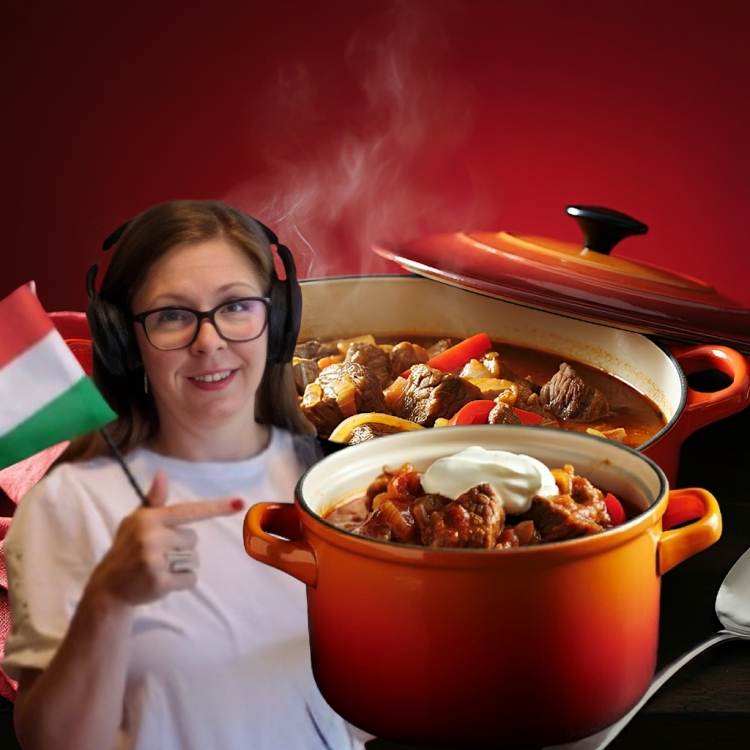
Authentic Hungarian Cuisine: Learn How to Talk About Hungarian Food
Share
Introduction
Some Hungarian courses teach the language backward.
Bizonyos módszerek fordítva tanítják a magyart.
Instead of focusing on words you’d actually use in conversation—like describing a dish or ordering food—they overload you with complicated grammar.
Ahelyett, hogy a valóban használt szavakra összpontosítanának – mint például egy étel leírása vagy rendelése – túlságosan összetett nyelvtannal terhelnek.
You can read and translate a paragraph but are lost when trying to say, "I’d like a gulyás, please," or ask for an extra spoon for dessert.
El tudsz olvasni és lefordítani egy bekezdést, de elveszel, amikor azt akarod mondani: „Egy gulyást kérnék,” vagy egy plusz kanalat kérsz a desszerthez.
Many learners spend hours memorizing formal phrases, but when it’s time to talk to a Hungarian chef, the words don’t come out.
Sok tanuló órákat tölt el a formális kifejezések memorizálásával, de amikor egy magyar szakáccsal kell beszélni, a szavak nem jönnek elő.
The good news? Everyday Hungarian can be learned quickly and is much simpler.
A jó hír? A mindennapi magyar gyorsan megtanulható és sokkal egyszerűbb.
For example, in written Hungarian, you’d say: “Mit szeretne enni?”
Például írásban így mondanád magyarul: „Mit szeretne enni?”
But in casual conversation, it’s much more common to say: “Mit kérsz?”
De egy kötetlen beszélgetésben sokkal gyakoribb, ha ezt mondod: „Mit kérsz?”
Spoken Hungarian is like a new language with its own rules and relaxed structure. Mastering it will make you much more comfortable ordering, describing food, and chatting in real settings.
A beszélt magyar szinte egy új nyelv, saját szabályokkal és lazább szerkezettel. Ennek elsajátítása segít magabiztosan rendelni, ételt leírni és valódi helyzetekben beszélgetni.
Click here to learn more what I say to someone who speaks Hungarian well.
Common Hungarian Food Vocabulary?
-
Adjectives for Taste or Texture:
- Finom – Delicious
- Erős – Spicy
- Édes – Sweet
- Savanyú – Sour
- Sós – Salty
- Pikáns/Fűszeres – Spicy
- Friss – Fresh
- Ropogós – Crunchy
- Puha – Soft
- Krémes – Creamy
- Lágy – Tender
- Zsíros – Fatty
- Sötét – Dark (as in dark chocolate)
- Világos – Light (as in light-colored food)
- Füstölt – Smoked
- Kész – Cooked
- Nyers – Raw
- Húsos – Meaty
- Sűrű – Thick
- Vékony – Thin
-
Common Food-Related Nouns:
- Leves – Soup
- Hús – Meat
- Kenyér – Bread
- Tészta – Pasta
- Gyümölcs – Fruit
- Zöldség – Vegetable
- Leves – Soup
- Hús – Meat
- Kenyer – Bread
- Tészta – Pasta
- Gyümölcs – Fruit
- Zöldség – Vegetable
- Sajt – Cheese
- Tojás – Egg
- Saláta – Salad
- Desszert – Dessert
- Fűszer – Spice
- Kávé – Coffee
- Tea – Tea
- Sör – Beer
- Bor – Wine
- Fagylalt – Ice cream
- Fokhagyma – Garlic
- Hagyma – Onion
- Paprika – Pepper (both the spice and the vegetable)
- Rizs – Rice
- Máj – Liver
- Gomba – Mushroom
- Burgonya – Potato
- Dió – Nut
- Cukor – Sugar
Common Hungarian Food Speaking Phrases
Mire szeretne rendelni?– What would you like to order?
– Please, a moment!
Hány személyre kérnek asztalt?
– How many people are you reserving a table for?
Kérem, egy italt!
– Please, a drink!
Van vegetáriánus étel?
– Do you have vegetarian options?
Milyen leves van ma?
– What soup do you have today?
Szeretnék egy desszertet.
– I would like a dessert.
Kérhetek extra fűszereket?
– Can I have extra spices?
Mi a napi ajánlat?
– What is the daily special?
Kérek egy tál salátát.
– I’d like a bowl of salad.
Egy adag sült krumplit kérnék.
– I’d like an order of French fries.
Milyen íze van ennek?
– What does this taste like?
Kérem, készítse el enyhén csípősen.
– Please make it slightly spicy.
Egy kávét kérek tejjel.
– I’d like a coffee with milk.
Ez micsoda?
– What is this?
Jöhet a számla, kérem.
– Could I have the bill, please?
Ez a legjobb étterem a városban!
– This is the best restaurant in town!
Kérem, szép lassan!
– Please, slowly!
Nagyon jó volt az étel!
– The food was very good!
Szeretnék valami újat megkóstolni
– I’d like to try something new.
Common Hungarian Dishes and Ordering Tips
- Gulyás – A hearty soup with beef, vegetables, and paprika.
- Paprikás csirke – Chicken with a rich paprika sauce.
- Hortobágyi palacsinta – Savory crepes filled with meat and paprika sauce.
- Halászlé – Spicy fish soup, often made with paprika.
- Lángos – Fried dough topped with sour cream and cheese, a popular street food.
- Pörkölt – A rich meat stew typically made with beef, pork, or chicken, seasoned with paprika and onions.
- Töltött káposzta – Stuffed cabbage rolls filled with minced meat and rice, often served in a tomato sauce.
- Lecsó – A vegetable stew made with peppers, tomatoes, and onions, often served with sausage.
- Jókai bableves – A hearty bean soup with smoked meat and vegetables, named after the famous Hungarian author Mór Jókai.
- Túrós csusza – Noodles mixed with cheese, sour cream, and often bacon.
- Káposztás tészta – Pasta mixed with cabbage and often garnished with crispy bacon.
- Főzelék – A thick vegetable stew, often made with potatoes, peas, or lentils, served as a main dish.
- Fagyi (Fagylalt) – Ice cream, a popular dessert especially in summer; often available in various flavors.
- Dobos torta – A layered sponge cake filled with chocolate buttercream and topped with caramel.
- Kürtőskalács – A sweet, spiral-shaped pastry, traditionally baked over an open fire and often coated in sugar.
Tips:
Be Specific:
When ordering, specify your preferences clearly. For example, “Kérek egy pörköltet, extra csípős paprika nélkül.” (I’d like a pörkölt, without extra spicy peppers.)
Ask About Ingredients:
If you have dietary restrictions or allergies, don’t hesitate to ask, “Milyen összetevői vannak?” (What are the ingredients?)
Try Local Specials:
Always ask, “Van napi ajánlat?” (Do you have a daily special?) to discover unique dishes that might not be on the regular menu.
Share Dishes
Hungarian dining often involves sharing dishes. You can say, “Osztanánk az ételeket.” (We’d like to share the dishes.)
Confirm Portion Sizes
If you're unsure about portion sizes, ask, “Mekkora adag?” (How large is the portion?)
Inquire About Side Dishes
Many main dishes come with side dishes. Ask, “Mivel tálalják?” (What is it served with?)
Ask for Recommendations
Feel free to ask your server for recommendations: “Mit ajánlana?” (What would you recommend?)
Use the Formalities
Use polite language to show respect, especially in traditional settings. Phrases like “Kérem” (Please) and “Köszönöm” (Thank you) go a long way.
Be Open to New Flavors
Hungarian cuisine has a unique flavor profile; be open to trying new dishes: “Szeretnék valami újat kipróbálni.” (I’d like to try something new.)
Learn About Traditional Pairings
Some dishes are traditionally served with specific sides or drinks. Familiarize yourself with these pairings to enhance your dining experience.
Or you can start learning about the rules and habits of modern everyday Hungarian and start understanding everyday Hungarian with our private lessons.
Click here to sign up for my FREE Hungarian Newsletter
Scroll down for the workbook exercises for this lesson!
Workbook Exercises for This Lesson
The rich meat stew made with paprika and onions is called __________.
When ordering food in a restaurant, you can ask, "__________ szeretne rendelni?"
A popular Hungarian dessert made of layered sponge cake filled with chocolate buttercream is called __________.
The dish __________ consists of stuffed cabbage rolls filled with minced meat and rice.
If you want to try something new, you can say, "Szeretnék valami __________ kipróbálni."
A thick vegetable stew is known as __________ in Hungarian.
The phrase "Kérem, jöhet a __________, kérem." means "Could I have the bill, please?"
The spiral-shaped pastry baked over an open fire is called __________.
When you want to ask what the soup of the day is, you would say, "Milyen __________ van ma?"
If you want to order a drink, you can simply say, "Kérek egy __________!"
Now Make this Hungarian Recipe: Lecsó (Vegetable Stew)
Here’s a simple recipe for Lecsó, a traditional Hungarian vegetable stew:
Ingredients:
- 3 medium bell peppers (red, green, or yellow)
- 2 medium tomatoes
- 1 large onion
- 2 tablespoons of oil (sunflower or olive oil)
- 1 teaspoon of paprika (preferably Hungarian)
- Salt and pepper to taste
- Optional: 1-2 sausages (like Hungarian kolbász) for added flavor
Instructions:
- Prepare the Vegetables:
- Sauté the Onions:
- Add the Peppers:
- Incorporate Tomatoes:
- Season:
- Serve:
Learn more about Hungarian Food here: https://streetkitchen.hu/
Ready to start your Hungarian language journey? Sign up for our FREE Hungarian Newsletter for weekly lessons, tips, and cultural insights!
Also, did you know you can schedule a FREE CONSULTATION to discuss your learning goals with us? Yes, you can do that here!
